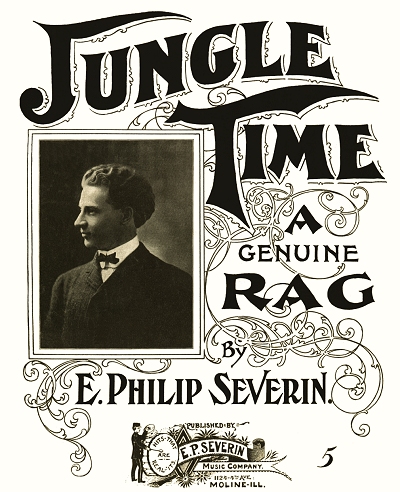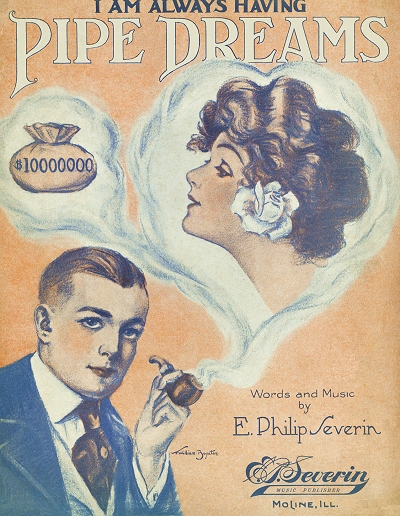Eric Philip Severin (possibly Erick at birth) represents yet another ragtime composer who had minimal yet high quality output, and on which only snippets of information can be found. Severin was born in Copley, Illinois, not far from Moline where he would spend much of his life, to Erick Nilsson Severin and Mathilda Johnson (some sources show Swanson), both Swedish immigrants. Eric Jr. was the youngest of four boys including Theodore (1867), Martin Bromars (11/1869) and Oscar (1/1874). Their father was a local merchant in Copley. Eric's year of birth shows as 1877 on his draft record, but Illinois birth records and Knox County records from 1886 confirm the 1876 birth year. By 1900 he was listed in Moline as a professional musician. The three younger siblings were still living with their mother who had been widowed in 1890, and Martin also appears to have died by that time. Also in 1900, Severin's first verifiable composition was published, Kentucky Korn-Kracker. There is a mention of another Severin piece, Lemon Blossoms, on the back, but no copy is known of to date. However, Lemon Blossoms does show up in copyright records for 1899. Philip followed these up in 1902 with Peanuts Frolic, and using print jobbers in various metropolitan areas managed to get it distributed in Chicago and New York, and possibly beyond.
There is a mention of another Severin piece, Lemon Blossoms, on the back, but no copy is known of to date. However, Lemon Blossoms does show up in copyright records for 1899. Philip followed these up in 1902 with Peanuts Frolic, and using print jobbers in various metropolitan areas managed to get it distributed in Chicago and New York, and possibly beyond.
 There is a mention of another Severin piece, Lemon Blossoms, on the back, but no copy is known of to date. However, Lemon Blossoms does show up in copyright records for 1899. Philip followed these up in 1902 with Peanuts Frolic, and using print jobbers in various metropolitan areas managed to get it distributed in Chicago and New York, and possibly beyond.
There is a mention of another Severin piece, Lemon Blossoms, on the back, but no copy is known of to date. However, Lemon Blossoms does show up in copyright records for 1899. Philip followed these up in 1902 with Peanuts Frolic, and using print jobbers in various metropolitan areas managed to get it distributed in Chicago and New York, and possibly beyond.In 1905 Severin self-published his first rag and best known work, the well-crafted Jungle Time: A Genuine Rag. It is a fairly difficult piece to perform well, and contains many classically based elements, yet is still very original as an exciting piano rag. In 1908 he was married to his wife Grace Atkinson. The following year, Jungle Time was doing well enough and had garnered sufficient attention that it was re-copyrighted and picked up by the Arnett-Delonais publishing house in Chicago. Around this same time he was evidently in the music sales business as well, being listed in Moline city directories as both a musician and a phonograph salesman. In 1910 his widowed mother is shown living with the couple in Illinois, and he is listed again as a musician, indicating he was perhaps as much a performer than a he was a composer. Also that year he added an entry into the glut of Native-American themed pieces that had proliferated since Hiawatha in 1901. Mona was self-published as both an intermezzo and a song. Copies are scant in this time, suggesting sales were soft, in spite of the quality of the piece, which was not typical for that genre.
Another stellar rag was introduced in 1911, Sky Rockets. While sales were not nearly that of Jungle Time, it did see service in a number of piano roll renditions. This was followed in 1912 by That Ever Lovin' Violin Man, which could have been a reaction to some of Irving Berlin's most popular pieces of that time, including Ragtime Violin and Alexander's Ragtime Band. In 1914 the Severins moved to Clear Lake, Iowa, for undetermined reasons. Mathilda also went along, living either with them or close by. He was not heard of in the music world for another four years, but the family had returned to Moline by 1918, as shown on his draft record. On that he is once again listed as "Musician/Composer/Publisher" and claimed no exemptions from fighting. However, the war was over within a few weeks after he registered, so Eric likely never served.
He was not heard of in the music world for another four years, but the family had returned to Moline by 1918, as shown on his draft record. On that he is once again listed as "Musician/Composer/Publisher" and claimed no exemptions from fighting. However, the war was over within a few weeks after he registered, so Eric likely never served.
 He was not heard of in the music world for another four years, but the family had returned to Moline by 1918, as shown on his draft record. On that he is once again listed as "Musician/Composer/Publisher" and claimed no exemptions from fighting. However, the war was over within a few weeks after he registered, so Eric likely never served.
He was not heard of in the music world for another four years, but the family had returned to Moline by 1918, as shown on his draft record. On that he is once again listed as "Musician/Composer/Publisher" and claimed no exemptions from fighting. However, the war was over within a few weeks after he registered, so Eric likely never served.Severin contributed to the war in the way many composers did; with another self-published piece. Rarin' to Go was a patriotic song, one of many that featured the figure of General Pershing on the cover on his famous white horse. Also from 1918 was the challenging Grand Concert Rag, his last of the genre. It is important to note that Severin was still publishing on his own, and was putting in a concerted effort as an independent musician to provide glowing rhetoric for the text descriptions, and the best possible distribution available to him. The same was true for his last known piece, (I Am Always Having) Pipe Dreams. It was a well scored multi-part waltz tune, complete with an obbligato line, intended for group vocal performance.
For the 1920 census Eric and Grace were shown still living in southwest Illinois in Moline, with Eric listed as a musician in an orchestra. They had two lodgers living in their home, neither of them musicians. It is hard to locate the Severins through much of the 1920s. However, by 1930 Philip and Grace as well as Mathilda, now 86, had moved to where much of the music industry had, Los Angeles. He was now listed as a musician in a theater orchestra (no particular organization specified), living in Long Beach, California. The viability of this is questionable with sound films overspreading throughout the industry, but it suggests that he spent at least part of the previous decade performing, even though composing is no longer indicated. There is some possibility that he had composed some of the music for films he had accompanied, though no verification of this.
It appears that the Severins relocated back to the Midwest by 1935, this time to Rochester near Tipton, Iowa. No children were ever indicated on any census, so the Severins likely had none. They were found in Rochester as of the 1940 census, Severin listed as a professional musician and piano tuner. Eric Severin died in nearby Tipton in the spring of 1942, followed by Grace several years later. They are buried together in Rochester Cemetery in Tipton, Iowa.
Some of the information of Severin's life was derived from the concerted efforts of Dave Jasen and Gene Jones in the book That American Rag published in 2000. It is a highly recommended source for a very different look at where ragtime came from and how it eventually reached the public.

 Compositions
Compositions